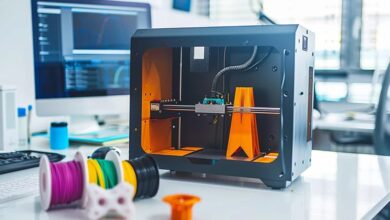Dubai unveils 3D printing strategy
His Highness Sheikh Mohammed bin Rashid Al Maktoum, vice president and prime minister and ruler of dubai, has launched the ‘Dubai 3D Printing Strategy’, a global initiative that aims to exploit technology for the service of humanity and promote the status of the UAE and Dubai as a leading hub of 3D printing technology by the year 2030.
Sheikh Mohammed announced: “The UAE is presenting to the world today the first integrated and comprehensive strategy to exploit 3D technology to serve humanity. We have also framed practical plans and precise goals to turn the strategy into reality, the reality that will contribute to the progress and prosperity of the world and help preserve our human heritage.”
The key goal of the strategy is to ensure that 25% of buildings in Dubai are based on 3D printing technology by 2030.
“The future will depend on 3D printing technologies in all aspects of our life, starting from houses we live in, the streets we use, the cars we drive, the clothes we wear and the food we eat. This technology will restructure economies and labour markets as the use of unskilled labour will come down compared to the current situation, especially in the construction sector. It will redefine productivity because the time needed for 3D printing of buildings and products will be 10% of the time taken in traditional techniques. It will also help reduce manpower requirements as well as waste generated from construction which can be harmful to the environment.,” he added.
His Highness called on all government agencies, private sector companies, universities and research centres to work as a team to establish a universal model in the UAE that will serve as a platform for innovators in this futuristic technology from all over the world.
There are three key sectors and five pillars of the strategy. The three major sectors are Construction, Medical Products, and Consumer Products.
The construction and building sector will focus on lighting products, bases and foundations, construction joints, facilities and parks, buildings for humanitarian causes and mobile homes, in addition to galleries, stores and residential villas. The value of the 3D printing technology based construction sector in Dubai is expected to be about AED3 billion by 2025. The use of 3D printing in Dubai’s construction sector will increase by 2% starting 2019 and more in the coming years, depending on the development of the technology and its future reliability.
In the medical products sector, the focus will be on developing 3D printed teeth, bones, artificial organs and medical and surgical devices and hearing aids. The value of 3D printed medical products in Dubai is expected to be reach AED1.7 billion by 2025.
The consumer products sector will focus on household items, optics, fashion jewellery, children’s games and fast food. The volume of consumer products printed by 3D technology in Dubai is expected to be about AED2.8 billion by 2025.
The strategy has five main pillars: Infrastructure, Legislative Structure, Funding, Talent and Market Demand.
The Legislative Structure pillar will focus on the development of regulatory frameworks for the use of 3D printing technology within various sectors and the specifications of materials that will be allowed to be used in the printing process.
The Infrastructure pillar will aim to provide the right infrastructure and the support of research and development to attract the world’s largest companies in this field.
Emphasis will be placed through the Talent pillar to build the local talent capabilities of researchers, designers and innovators, and bring the best minds from around the world in the 3D printing field.
The Funding pillar will provide financing alternatives as well as investment support to develop the technology and expand its scope of application.
The Market Demand pillar will promote the application of this technology within various sectors, to bring prices of products to competitive levels while maintaining quality.
The Dubai 3D Printing Strategy will be implemented by many partners, including Dubai Municipality, Dubai Health Authority and Dubai Holding. The strategy is aimed at integrating the efforts of government institutions and the private sector to enhance Dubai’s development by employing innovative local and global expertise in 3D technology. The Dubai Future Foundation will play a major role in organising these efforts and putting them within set frameworks to achieve the strategy.
Dubai Municipality will be one of the important government agencies involved in the implementation of the strategy through the use of existing technologies locally and attracting the leading global companies in the industry. It will also analyse the optimal mechanisms to successfully transform traditional construction methods to construction using 3D printing technology.
Dubai Municipality will achieve the strategic targets by launching and organising a number of projects and initiatives across four main stages. The Establishment Phase includes preparation of a comprehensive study for the 3D printing sector, especially in the field of building construction. It will contribute to the organisation of the registration process and qualification and licensing, implementation and follow-up monitoring and modification and legislation, as well as coordination with the customers, government, developers, manufacturers, and information technology companies.
The Qualification Phase aims to organise projects to develop codes for 3D printing materials, systems and specifications, hardware and technical standards of sustainability and project maintenance. In addition, this phase will adopt the registration and classification process and initiate measures to educate engineers and local and international companies. The phase will also see the preparation of laboratories for testing and measuring the materials. It also includes local and international accreditation and processing and preparation of cadres and electronic systems for operations and inspection.
The third stage is the Implementation Phase, which will begin with the launch of the first pilot project with Dubai Holding. During this phase, developers will be inspired to work on other prototype projects while the private sector and consultants will be encouraged to adopt the processes of transformation towards printing buildings through a combination of direct impact incentives.
The Development Phase includes assessment through several measures and performance indicators covering all the previous stages, and further developing them, drafting work agreements with key developers to facilitate the 3D printing technology sector.
The Dubai Health Authority will help in achieving the goals of the strategy within the medical products sector by creating an appropriate environment and setting the standards to apply to this technology in the medical sector, as well as to promote Dubai’s position as a global centre for 3D printed medical products, building international partnerships with key players around the world.
Dubai Holding will also play a key role in implementing Dubai’s strategic 3D printing through the launch of an innovative laboratory to embrace innovation, innovators and designers. It will establish a special centre for 3D printing and organise workshops and training courses. This is in addition to the establishment of a special fund to support pilot projects in a wide range of sectors, including 3D printing.
The global market for 3D printing is expected to reach US$120 billion by 2020 and about US$300 billion by 2025. Reports indicate that 3D printing technology will cut construction costs by between 50% and 70%, and cut labour costs by 50% to 80%.
In addition, the technology will help reduce waste produced in construction operations by up to 60%, which will reflect positively on the economic returns of the sector and contribute to sustainable development.
North America, Japan, Germany, the United Kingdom and other developed countries have allocated huge budgets in the development of 3D printing techniques in various fields such as medicine, industry, automotive and aviation.





